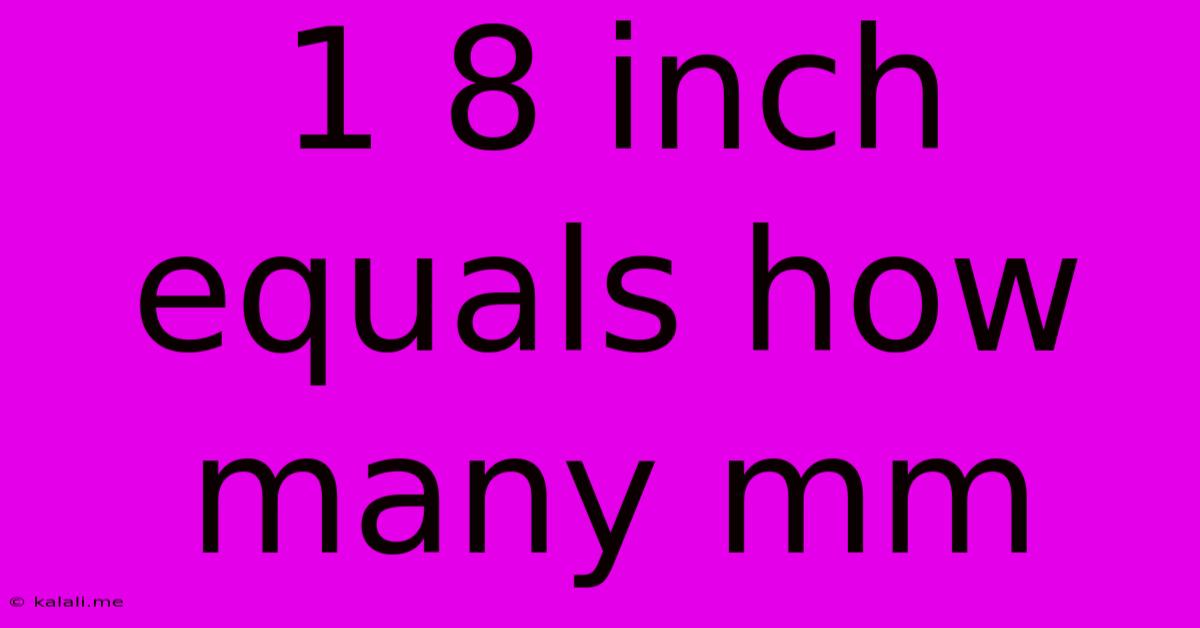1 8 Inch Equals How Many Mm
Kalali
May 09, 2025 · 3 min read

Table of Contents
1 Inch Equals How Many Millimeters? A Comprehensive Guide
Meta Description: Wondering how many millimeters are in an inch? This comprehensive guide explains the conversion, provides the formula, and offers practical applications for this essential conversion.
Converting units of measurement is a common task, especially when working with international standards. One frequently encountered conversion is that of inches to millimeters. This guide will clearly explain how many millimeters are in one inch, provide the formula for broader conversions, and offer some real-world examples.
Understanding Inches and Millimeters
Before delving into the conversion, let's quickly define our units:
- Inch (in): A unit of length in the imperial and US customary systems of measurement.
- Millimeter (mm): A unit of length in the metric system, one thousandth of a meter.
The metric system is based on powers of 10, making conversions relatively straightforward. The imperial system, on the other hand, uses less intuitive relationships between units.
The Conversion: 1 Inch to Millimeters
One inch is equal to 25.4 millimeters. This is a fundamental conversion factor used across various fields, from engineering and manufacturing to woodworking and design.
Remember this key figure: 1 in = 25.4 mm
Calculating Conversions: The Formula
To convert inches to millimeters, you simply multiply the number of inches by 25.4. The formula is:
Millimeters = Inches × 25.4
For example, to convert 5 inches to millimeters:
Millimeters = 5 inches × 25.4 mm/inch = 127 mm
Conversely, to convert millimeters to inches, you divide the number of millimeters by 25.4:
Inches = Millimeters ÷ 25.4
Practical Applications of Inch to Millimeter Conversion
This conversion is crucial in numerous applications:
-
Engineering and Manufacturing: Precise measurements are vital in these fields. Converting between inches and millimeters ensures compatibility and accuracy in designs and manufacturing processes involving both imperial and metric systems. This is especially important in international collaborations.
-
3D Printing and Design: Many 3D modeling software and printers allow for input in both inches and millimeters. Understanding this conversion is essential for accurately creating and printing designs. Adjusting the scale of your designs often necessitates this conversion.
-
Woodworking and Carpentry: Whether you're working with blueprints from different countries or using tools with different measurement systems, knowing this conversion helps avoid errors in cutting and assembling projects. Accurate measurements prevent material waste and ensure a proper fit.
-
Everyday Measurements: While not as frequent as in specialized fields, understanding this conversion can be helpful in various everyday situations, such as measuring the dimensions of furniture or electronics.
Beyond 1 Inch: Handling Multiple Inches
The formula provided earlier seamlessly handles conversions for any number of inches. Simply substitute the desired number of inches into the equation to find the equivalent in millimeters. This simple equation makes complex conversions easy and accessible for anyone.
Conclusion
Understanding the conversion of inches to millimeters is a valuable skill with applications across various disciplines. Remembering the key conversion factor – 1 inch = 25.4 millimeters – and understanding the associated formula will empower you to perform these conversions accurately and efficiently. This knowledge is essential for ensuring precision and compatibility in numerous projects and tasks.
Latest Posts
Latest Posts
-
7 2 3 As An Improper Fraction
May 09, 2025
-
What Is 3 Minutes In Seconds
May 09, 2025
-
How Many Lines Of Symmetry Does A Diamond Have
May 09, 2025
-
80 Is What Percent Of 120
May 09, 2025
-
At What Temperature Does Your Blood Boil
May 09, 2025
Related Post
Thank you for visiting our website which covers about 1 8 Inch Equals How Many Mm . We hope the information provided has been useful to you. Feel free to contact us if you have any questions or need further assistance. See you next time and don't miss to bookmark.